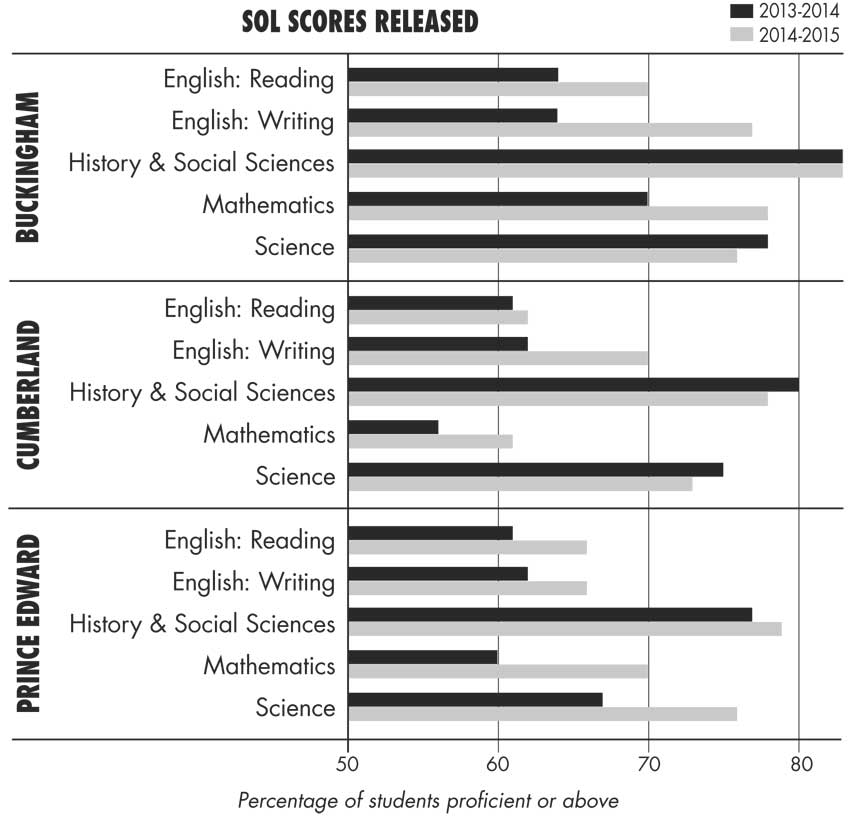Area schools see SOL performance improve
Published 6:00 pm Thursday, August 13, 2015
By Rob Chapman and Jordan Miles
The Farmville Herald
Across the board, area schools saw improvement in Standards of Learning (SOL) pass rates released by the state Department of Education Tuesday.
Prince Edward
The reading pass rate divisionwide for all students increased from 61 to 66 percent, writing improved from 62 to 66 percent, history and social science scores rose from 77 to 79 percent, math jumped from 60 to 70 percent and science rose from 67 to 76 percent.
Division Superintendent Dr. David Smith said he is “very encouraged by the gains we’ve made in a number of areas. There’s still some areas where there’s work needed and that is continuing, but it appears that at the elementary and middle and the high school level, there were significant gains in mathematics scores. And there were gains in many areas in English scores as well, but it doesn’t appear that the gains in English may have been enough to bring them above the benchmark. But it does appear that math at all three levels may have been enough to bring them above the benchmark.”
Accreditation ratings are expected to be released in mid-September.
“We give a lot of credit to our teachers and our building administrators,” Smith said. “I know they’ve worked extremely hard over the last year to make improvements in instruction so the student achievement scores would be higher. They worked really hard together at grade levels and in subject specific departments at the high school and … at the same time they’re adapting to more rigorous tests, which of course every year are a challenge for scores. But … we’re really proud of the work that our teachers are continuing to do.”
Middle school results in reading increased from 58 to 62 percent, from 53 to 63 percent in writing, from 76 to 77 percent in history and social studies, from 56 to 64 percent in math, and from 61 to 73 percent in science. The school was accredited with warning at the state level last year, but having failed to meet federal targets, was deemed a Title I Focus School.
Elementary school reading results increased from 56 to 64 percent for all students, and math rose from 64 to 75 percent. The elementary school was accredited with warning at the state level last year.
The high school, within one three-year average point in reaching state accreditation last year, held steady. Reading, which came in at 84 percent the previous year, fell one percentage point, and history and social sciences increased from 79 to 80 percent among all students. Science rose from 72 to 78 percent, but writing took a big dip, from 79 percent to 69 percent.
It is an area, Smith said, that administrators are targeting for improvement this year. “We’re beginning to work with the high school principal right now to map out the plan for that,” he said.
One thing that helped scores across the state was an allowance for first-time students scoring within 25 points of the 400 required passing level in third through eighth grades to retake the test. In Prince Edward’s case, 114 additional students passed SOL tests as a result.
“We are so grateful to the state Department of Education and state legislature for making that happen and, especially, for making it happen on very short notice,” Dr. Smith said.
Buckingham
Only one subject subgroup saw a decrease in SOL scores last year in Buckingham compared to the previous school year.
Among all students, the percentage proficient or above in science saw a two-point drop divisionwide, while gains were made in reading, writing and math. History and social sciences remained unchanged, compared to 2013-14 scores.
The largest gain came in writing; the pass rate jumped 13 points from the previous year.
The elementary school saw increases in reading, history and social sciences and math with a decrease in science. At the high school, reading and math scores increased, while there were decreases in writing, history and social sciences and science. At the middle school, student scores increased in reading, writing and math, with decreases in history and social sciences and science.
“What the numbers tell me,” said Division Superintendent Dr. Cecil Snead, “is that a lot of the support and professional development we’re putting in place to support each one of our individual students with regard to reading and mathematics and pedagogy may be working.”
Snead said more focus has been placed on student goal setting, textbooks and new instructional technology.
He credited “teachers understanding the curriculum framework and being able to apply that in the classroom on a daily basis.”
“It does go back to our teachers. Our teachers are getting it done.”
Last fall, Buckingham’s high school was the only fully accredited school in the division by state and federal guidelines; the primary and elementary schools were listed the bottom 10 percent of performing schools in the state, receiving the designation of being Title I priority schools.
Snead says that, because of the new figures, the division is going to shed the label of accredited with warning at the elementary school in math. He believes they will miss the benchmark “by just one or two percent in reading at the middle school,” though scores improved seven percentage points.
“It just really feels good to know that my students and my teachers are being successful,” he said. “It shows that hard work does pay off.”
Cumberland
Cumberland County students scored better in reading, writing and math last year compared to the previous school year, according to the data.
Among all students divisionwide, the percentage proficient or above fell in history and social sciences and science.
The largest gain was in writing; an eight-point increase was made among all students. The greatest declines were losses of two points in both history and social sciences and science.
Reading and math scores at the elementary school scores increased. At the middle school, increases were seen in all categories — science, math, history and social sciences, writing and reading. At the high school, decreases were seen in reading, history and social sciences, math and science, while gains were made in writing.
Last year, Cumberland High School was the only school in the division that achieved full accreditation based on state and federal guidelines.
“It tells me that we’re moving in the right direction in language arts and math … In history and science we need to work more on alignment and looking at the curriculum framework,” said Division Superintendent Dr. Amy Griffin of the divisionwide scores. She said the division is also examining student engagement in the classroom.
“At the elementary level, we made a small gain overall for English and math,” Griffin said. She noted the division made major gains in the fourth grade in English and math.
At the elementary school, which last year was designated as a focus school, or a Title I school with one or more proficiency gap groups not meeting performance expectations, the data indicated that an achievement gap had been closed. The gap resulted in the focus school designation, she said.
Griffin said the scores indicated that initiatives and strategies put in place last year were working.
For more information about SOL pass rates for all area schools, see http://www.doe.virginia.gov/statistics_reports/accreditation_federal_reports/index.shtml#passrates.






